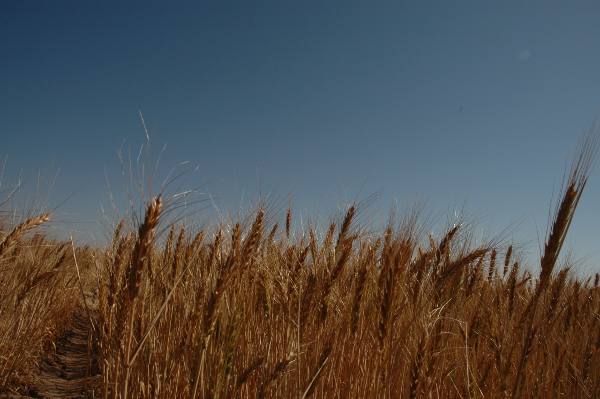
Variety trials show which varieties offer the best possibilities for improved yield under extreme environmental conditions.Farmers who choose recommended varieties from the Extension “picks list” can expect to produce more wheat per acre.Two new varieties give producers more options.

Wheat variety trials at the USDA-ARS and AgriLife Research station in Bushland, Texas, may provide High Plains wheat farmers with new cultivars to combat insects, diseases and drought. Tests also show which varieties offer the best possibilities for improved yield under extreme environmental conditions.
Researchers provided updates on some of the work in progress during a wheat field day at the station in late May.
Qingwu Xue, a Texas AgriLife Research crop stress physiologist, discussed drought tolerance. “We’re trying to identify plant traits that geneticists can use to make better materials,” Xue said. “Drought tolerance is an important management strategy for improving yield and water use efficiency under water-limited conditions.”
Two recent Texas A&M wheat releases, TAM 111 and TAM 112 are considered drought resistant. But Xue says the mechanisms that make each of these varieties less susceptible to drought stress may be different. He is working on a study to investigate “the physiological determinations of yield and water use efficiency in these two wheat cultivars as compared to cultivars released earlier—TAM 105 and TAM 110.”
The test covered two growing seasons (2010 and 2011) with very different precipitation outcomes.
He said during both seasons research noted “genetic differences in yield, yield components, and water use efficiency among the cultivars with almost extreme precipitation regimes.” TAM 111 and TAM112 “were consistently more drought resistant than TAM 105.”
But the two top performers also showed differences in the way they responded to drought conditions. “TAM 111 showed drought avoidance characteristics,” Xue said. That included a cooler canopy and using more water from deeper in the soil. It also remobilized more carbon from stems than did other cultivars, he said.
TAM 112 “might have drought tolerance characteristics,” he said. Those include osmotic adjustment, desiccation tolerance, etc.
Xue said research has looked at the most popular varieties in the South Plains, and TAM 111 and TAM 112 have been the best the past two years in his tests. He also said that 30 years of breeding efforts improved yield characteristics of High Plains wheat varieties.
Variety selection can make a big difference in wheat production, said Calvin Trostle, Texas AgriLife Extension agronomist.
He said farmers who choose recommended varieties from the Extension “picks list” can expect to produce more wheat per acre than if they planted varieties not on that recommended list.
“Yield…represents the primary basis for highlighting individual varieties that are adapted and perform well across the region and in different environments,” he said.
Variety trials from 2009 through 2011 prove the point. The overall average yield of all varieties in the tests came in at 59.3 bushels per acre. The average yield of “non-pick” varieties was 58 bushels per acre, averaged all three years. The recommended varieties averaged 64.8 bushels per acre over the three-year trial, a 12 percent advantage.
In 2009, recommended varieties outperformed the non-picks by 19 percent.
Trostle also cautioned wheat farmers about fertility. “We spend a lot of time on topdressing nitrogen,” he said. “A lot of farmers apply about two weeks later than they should.”
Texas AgriLife wheat breeder Jackie Rudd said two new varieties will give producers more options.
“TAM 305, marketed through Adaptive Genetics, will be available for fall planting,” he said. The new variety offers a high grain yield and has a good disease resistance package. It also has good baking and milling qualities.” TAM 113 is another newly released variety.
Sally Clayshulte, Bayer CropScience, discussed Bayer’s recently announced initiative with Texas A&M on wheat breeding work. ‘In 2009 we decided to make wheat a core crop for Bayer,” Clayshulte said. She said adding Texas A&M as a research partner “adds some southern germplasm” to the effort.
‘We are excited about new interest in wheat,” Rudd said. “We’re better off with more players.”
About the Author(s)
You May Also Like





